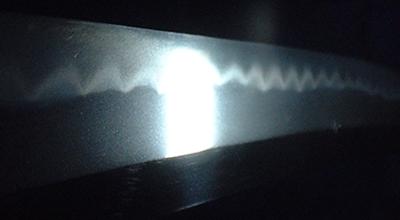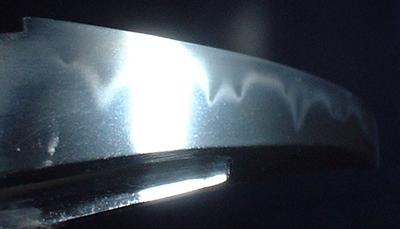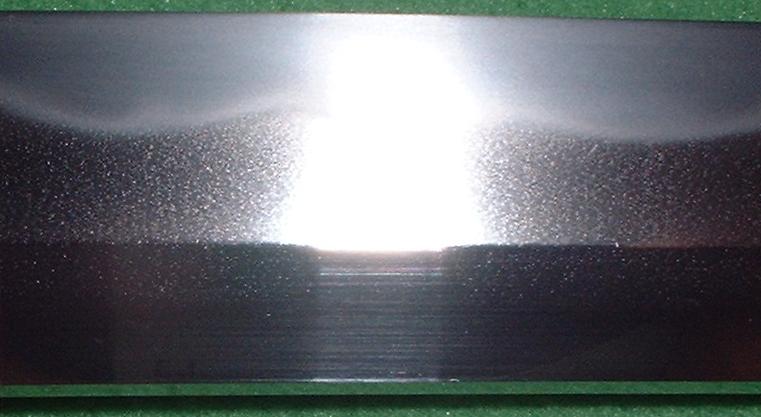SUNOBE blade (Non-traditional Japanese sword)
There are Japanese blades made from modern steel in 20th century. Most
of them are in the military mount. They are called "SUNOBE blades".
They don't have any layer pattern, and the steel color is different from traditional swords'. The hamon area is black like a mirror, and the remain surface is misty dim. No activities of steel particles. Because the quality of the steel is same as cheep as the material.
This kind of blade is not an object to be appreciated as art. It is just a weapon or an antique. We have to distinguish between traditional Japanese blade and modern steel blade (SUNOBE).
"SUNOBE blade"
This is a military sword in 20th century.


Another example of modern steel blade"
This is a souvenir from the early 20th century or the end of 19th century.
It should be called knife rather than "tanto".


In literal meaning, the word "SUNOBE" describes the process of
drawing out the steel block to the blade length. The naming for such blade
comes from its easy process of making, because the blade was made up without
fold'n welding work. Of course, fold'n welding process is not necessary
for modern steel.
In Japanese market, a price of SUNOBE blade is far lower than traditional
blade's. Therefore some kind of dealers confuse beginners between sunobe
blades and traditional blades to make their wrong business.
Usually we use the word "SUNOBE" for all blades made of modern
steel. But in exact meaning, it should be used to the blade made from one
block of modern steel without fold welding. As a matter of fact, there
are various kinds of non-traditional blades in Japanese style.
Other words around Traditional and Non-traditional Japanese swords.
There are many words to confuse sword collectors. Some dealers are using
such words as they like.
SHOWA-TO, this word is used as same meaning of "SUNOBE". The
literal meaning of "Showa-to" is "blade in Showa era".
So this word makes beginners confuse to "All blades in Showa era are
non-traditional".
GUNTO, "Gun-to" means "military swords". This word
can be used for the same meaning of Showa-to, because most of "Gun-to"
were sunobe blade. But some officers put really good traditional blade
into their military mount.
MURATA-TO, a sunobe blade in Meiji period.
TANREN-TO, "Tanren" means fold'n welding work in this case, and
this word was used as traditional Japanese sword to distinguish it from
non-traditional swords. But this word can't distinguish the swords what
fold welded with modern steel. A layer pattern is not the proof of traditional
sword.
HAN-TAN-TO, it means "half" tanren-to. It doesn't make sense,
but old dealers like to use this word. The real meaning of this word is,
a blade made with non-folded modern steel, but using several kinds of steels
to construct it.
MANTETSU-TO, a kind of blades what a Japanese company made in Manchuria
in WWII. It is constructed with modern steels those are hard steel pipe
and soft steel core.
NIHON-TO/NIPPON-TO, Nihon or Nippon means Japan. So it should be used only
for traditional Japanese swords. But sometimes it is used as the meaning
of Japanese style sword.
SHIN-NIHONTO, "Shin" means new, so it means "new Japanese
sword". It is a kind of blade constructed with several kinds of modern
steels. But I don't know exactly.
SPRING-TO, it is a modern steel blade tempered like spring, no hamon. Usually
it is plated with chrome and a hamon-like pattern is put on it by sand-paper
polishing.
JAPANESE SWORD/JAPANESE BLADE, we use this word as the meaning of traditional
Japanese sword, but some people think it as the sword made in Japan. It
may be not wrong. We can't help the confusion.
One example of close-up picture.
This sunobe blade is well polished by the modern style. It is made of non-folded
modern steel. The grain on the surface is not made of particles, but it
is made of full of small dimples. There is no particles on the steel surface.
So the steel is not bright, it is dim and misty color.
In the exact meaning, this is not a sunobe, because a soft steel appears
on the shinogi-ji. It should be called Han-Tan-To.

For advanced persons
Today in 21st century, there are some strange Japanese styled swords that
have a visible layer pattern and a strange steel color. The steel is made
by the fold welding method using some different kinds of modern steel.
The worth of such blade is same to a SUNOBE blade. Any layer pattern designs
have no meaning for steel quality. For modern steel, fold welding work
has no effect onto its quality. The layer pattern design is only attraction
for eyes. It is called "Pattern welding" or "Modern Damascus".
To well recognize the color and the particles of steel is very important to appreciate Japanese blades. ( => steel ) But I am afraid that in the future it will become difficult to distinguish
the traditional Japanese blade from others.
-Notice-
In Japan, non-traditional blades are illegal. We can't have such blades.
Japanese citizens are not allowed to have any weapons.
Japanese style sword that made of modern steel is illegal, even if it has
pattern welding.
Only the blades made of traditional method and material can be recognized
as cultural assets. The educational office put a registration card on each
blade to prove it as cultural asset. Japanese citizen can have swords only
as cultural asset. Blades what can't get the card are disposed by the police.
Never try to bring such illegal
sword into Japan.
Home > Terms > Sunobe
